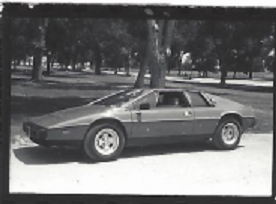
Lotus this month (July 2018) celebrated its 70th anniversary at the Goodwood Festival of Speed in West Sussex, England.
Most of us recognize the Lotus marque, one of the most iconic in the world of sports cars and racing.
Few, though, have driven one.
It was a week in July 1980 that I got a turn, one Lotus among the more than 2,000 cars I’ve driven and written about over the years.
It was an ’80 Lotus Esprit S2, built in England, and provided to me by Bill Stewart’s Royal Carriage at My Garage, 455 Broadway, in Denver.
It was late afternoon when I walked into the garage and Stewart handed me the keys. How do you sit in a car that’s only 43 inches high? You don’t. You almost lie down in the leaned-back racing-type seat with built-in headrest. As two-seaters go, this one was tight but somewhat comfortable. The only discomfort came in getting in and rolling out of it.
I drove to Greeley, where my oldest son, Kurt, would soon begin his senior year at the University of Northern Colorado, then headed out U.S. 34 to the east. I detoured onto some country roads, on through Fort Morgan and to Sterling, where a month earlier we had returned to devote time to automobiles and book-publishing, in addition to my newspaper work.
The Lotus was a brilliant performer on the country curves. It was very fast. Its manufacturer said it would hit 35 miles per hour in 1st gear, 55 in 2nd, almost 80 in 3rd, 105 in 4th and 130 in 5th. It was the fastest I’d driven a car until some years later, when the big guys such as Bentley Arnage, Jaguar XJ Super V-8 and Cadillac CTS-V began coming my way.
I well remember, with the help of brother-in-law Dave Wagner Jr., the return trip to Denver a week later. After passing Hudson, the clutch began to fail (did I mention the car was built in England?) and we limped it in to Stewart’s Royal Carriage, where his shop would put the speedster back in running order.
Price tag on the Lotus was $30,000. The only models I drove with higher tags back then were an ’81 Maserati Merak SS at $42,637, an ’80 Porsche 928 at $39,024 and an ’81 Mercedes 300SD turbodiesel at $35,345.
The Lotus’ inline-4-cylinder engine, slanted 38 degrees, was of 120-cubic-inch-displacement with twin overhead camshafts and Zenith twin carburetors. The engine compartment was reached by lifting the rear hatch and unbuttoning a tonneau cover.
An interesting feature of the Esprit was its two fuel tanks, with filler tubes on either side of the car. A balance pipe leveled the fuel between the two tanks, and it was necessary to service both sides for an absolutely full supply. The Lotus averaged 20 to 25 miles per gallon, with capacity of 17.7 gallons.
The 2,300-pound Lotus was on a wheelbase of 96 inches; it was 168 inches in overall length, 73 inches wide and had ground clearance of 6 inches.
The interior was of custom leather, brown suede, electric windows and a Blaupunkt AM/FM radio.
The Lotus company was begun in 1948, when Colin Chapman built his first competition car in a small London garage.
In addition to 2018 marking the 70th anniversary of Lotus’ birth, it also denotes 50 years since Graham Hill took the Formula 1 championship in the Lotus Type 49 and 40 years since Mario Andretti won his world championship in the Lotus Type 79.